#yoruba religion
Explore tagged Tumblr posts
Text
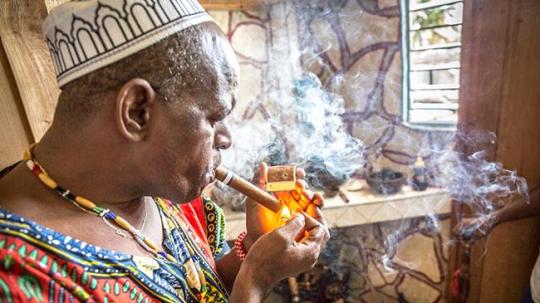
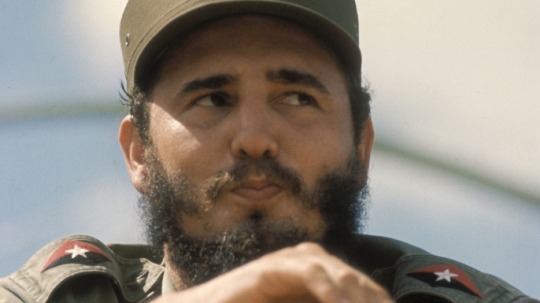

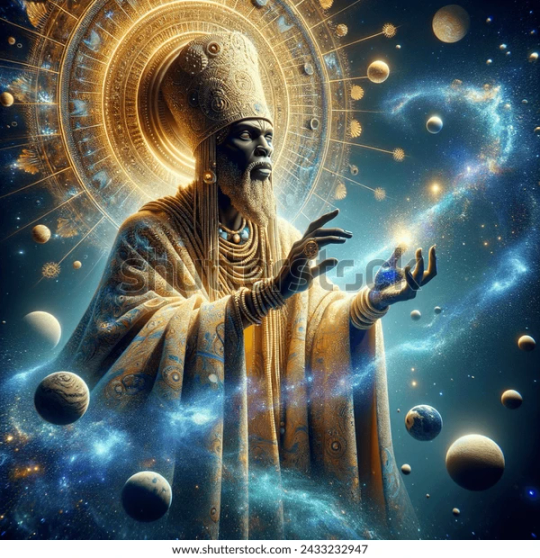
Yoruba gods protect Fidel Castro: priest
By Reuters
January 21, 20083:31 PM ESTUpdated 17 years ago
HAVANA (Reuters) - Yoruba gods protect ailing Fidel Castro from witchcraft and want to see him continue leading Cuba, the first priest of the Santeria religion to be elected to parliament said on Monday.
"Olodumare says he is the one that should be there and so he is untouchable," said Antonio Castaneda, a babalawo (priest) in the religion slaves brought to colonial Cuba from Nigeria.
Hurricanes may batter Cuba this year, but Castro's health will not break, according to the orishas (deities), he said.

The 614-seat National Assembly elected on Sunday must approve Cuba's top leadership at its first session on February 24, when Cubans will learn whether Castro will retire as head of state.
Castro, 81, has not appeared in public since stomach surgery for an undisclosed illness forced him to hand over power temporarily to his brother almost 18 month ago.
Santeria followers have believed their gods were on Fidel Castro's side ever since a white dove landed on his shoulder during a victory speech in Havana after his 1959 revolution.

Castaneda, who played the sax at Havana's famed Tropicana cabaret for 30 years, never joined Cuba's Communist Party, but considers himself a "revolutionary." He praised Cuba's social safety net despite widespread economic hardships Cubans face.
He said 60 percent of Cubans believe in Santeria and he can give them a voice in the National Assembly. Castaneda won a seat as president of the Yoruba Cultural Association of Cuba, which is close to the government.
The orishas augur a good year for Cuba, the babalawo said. "If Cuba marches ahead, so too does the Comandante," he said.

#fidel castro#yoruba#yoruba people#yoruba culture#african culture#afrakan spirituality#african spirituality#yoruba religion#yoruba spirituality#african#afrakan#kemetic dreams#africans#brownskin#brown skin#afrakans#cuba#cuban#cubana#shango#oludamare#orisha#orishas
16 notes
·
View notes
Text
Remember even in the darkest times you are never alone
The spirits, your ancestors, and the Orishas themselves walk beside you
With them by your side nothing can block your path for long
Ashe
#Orisha#African powers#Santeria#Ifa#Yoruba#yoruba religion#Ellegua#Obatala#ogun#Shango#Oba#Oya#Yemaya#Oshun#Olokun#Babaluaye#Ashe#Ancestors#400+1#Cuban#Mexican#Protectors#Olodumare#haitian vodou#Loa
126 notes
·
View notes
Text
IS IFA INITIATION (ITEFA) RIGHT FOR YOU?
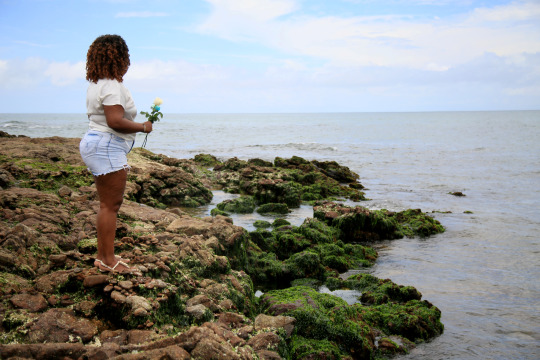
I get asked about Ifa initiation often by clients seeking to embrace this tradition. It has become a popular topic of discussion throughout the diaspora community. It tends to be a big deal among the African diaspora because we have been separated from our traditions for so long. And many want to connect with them as quickly and deeply as possible. So, they often consider initiation early on in their journey.
But what many aren’t aware of is that initiation is not required for everyone. It is a beautiful and blessed part of an Ifa spiritual journey. But this process is not mandatory to enjoy a fruitful and beneficial spiritual practice. So, it’s definitely not something you must rush into.
Even more, many don’t realize that all Ifa devotees in Yorubaland don’t go through initiation. Instead, some only receive the Hand of Ifa and continuously work with their Orisa icons. This is because everyone is not called to initiate. In fact, it is a rarity for initiation to be a requirement for anyone. Contrarily, it is primarily a personal choice for the average person.
SHOULD YOU INITIATE?
Initiation into the Ifa tradition is a powerful and significant event in the lives of those who practice it. This ancient and sacred ritual, referred to as Itefa, involves a complex set of prayers, ceremonies, sacrifices, and offerings. Those who are initiated into the Ifa tradition are granted access to higher-level spiritual teachings and knowledge. Likewise, they tend to have stronger connections to Ifa and specific Orisas once they endure this process. So there are many benefits to initiating into the Ifa tradition.
But keep in mind that this is not the only way to achieve higher spiritual connection and communication. In fact, some people are naturally born with such abilities without going through this specific process. Instead, these individuals endure initiation through personal circumstances and challenges that give them a similar level of spiritual connectivity.
Beyond having basic knowledge of what initiation is and its benefits, there are other considerations you need to think about before making such a move. I have outlined a few of them below.
COST OF INITIATION
One of the first things to consider before initiating is the cost of this process. For the average person, paying initiation fees can be quite exorbitant. While prices vary, I have seen costs between $5,000-$30,000 for various types of Ifa initiation ceremonies.
And keep in mind that these fees typically only include elements related to the initiation. You will typically have to pay your own airfare and other transportation-related costs if traveling for such an endeavor. However, room and board may be included in your initiation fees. So, you should definitely ask about this element and be prepared for it before taking this step.
GODPARENT SELECTION
Before you initiate, you need to have a strong connection with and understanding of the individual who will be initiating you. Likewise, you should be familiar with the other initiates and members of the temple where you plan to initiate. Though it’s not mandatory for you to like every member of the temple, you should have a decent relationship with them for the most part.
Beyond the semantics of social dynamics, the Babalowo (Priest) or Iyanifa (Priestess) who conducts your initiation should be qualified to do so. As such, you should take your time to get a feel for the quality of the individual’s work beforehand. This is usually done by getting divination and ebo performed regularly to determine the effectiveness of such solutions.
POST-INITIATION REQUIREMENTS
Keep in mind that initiation doesn’t automatically make a person righteous, infallible, or all-knowing. Nor is a person considered a spiritual leader simply because they initiate. There are additional requirements beyond initiation that set the stage for one’s spiritual growth and development.
Initiates are expected to learn and practice the teachings of Ifa and adhere to its moral code. Also, they must live with respect for their ancestors, community, and environment. Becoming an initiate also means taking on certain responsibilities as part of your role in the community. These responsibilities include maintaining a strong connection with the Orisa and honoring tradition. You must also serve as a bridge between the spiritual and physical worlds for others who may require your assistance.
Initiation is only the beginning of a joyous, transformative existence. Though it may come with ups and downs, it is meant to be the start of a cataclysmic change in your life. It is not the peak or conclusion of such a journey, as your process of spiritual growth and development is never-ending.
OUTCOMES OF ITEFA
Aside from the above-mentioned benefits of initiation, the following list outlines what you can expect from the process:
A rebirth process that further integrates you into the Ifa tradition
A holistic understanding and profound knowledge of Self
Comprehensive understanding of personal taboos
Deeper knowledge about your existence, purpose, and path
Enhanced relationship with and connection to your Head Orisa
Ability to overcome extreme or unrelenting difficulties and hardships
WHEN SHOULD YOU INITIATE?
The decision to initiate is very personal. As outlined above, it should be made with careful consideration. But beyond these factors, the choice of when to initiate should be made based on when you are ready to do so. No one should ever pressure you to initiate, even if it comes up in a reading. And keep in mind that it is a rarity for someone’s reading to indicate that they must initiate.
Instead, some of the best Babalawos and Iyanifas I have worked with often discourage new devotees from initiating too soon. That is unless it is a matter of life and death, which is not typical. Usually, these individuals won’t initiate someone until they deem the individual ready for such a process.
Unfortunately, in today’s world, some people use unscrupulous tactics to pressure others into initiation. Typically, they will say that initiation is a requirement or that something bad will happen to the person if they don’t initiate right away. Or they will otherwise compel them into going through the process. But note that such practices are not part of the Ifa tradition.
Contrarily, people are usually encouraged to wait until they feel ready for initiation. This may take months, years, or decades. Or it may never come to fruition. And that’s perfectly fine. Anyone considering this path should do so when they are spiritually, mentally, emotionally, and financially ready for it.
11 notes
·
View notes
Text

Lord Shango (1975)
by Ray Marsh
9 notes
·
View notes
Text
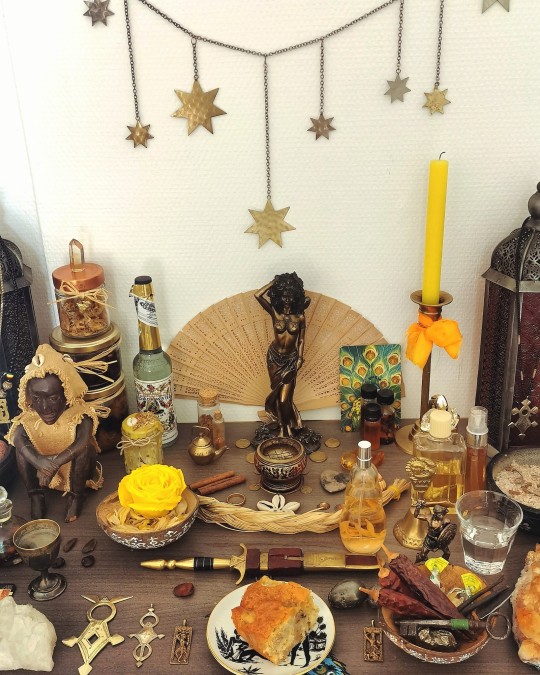
#oshungoddess#oshun#santeria#candomble#yoruba#ifa#aesthetic#atr#african traditional religions#orishas#ogun#hoodoo#african spirituality#afro witch#witches of color#west africa#florida water#oxum#keys#yellow flowers#iron#altar#my altar#offerings#blessings
694 notes
·
View notes
Text
💕Goddesses of love💕
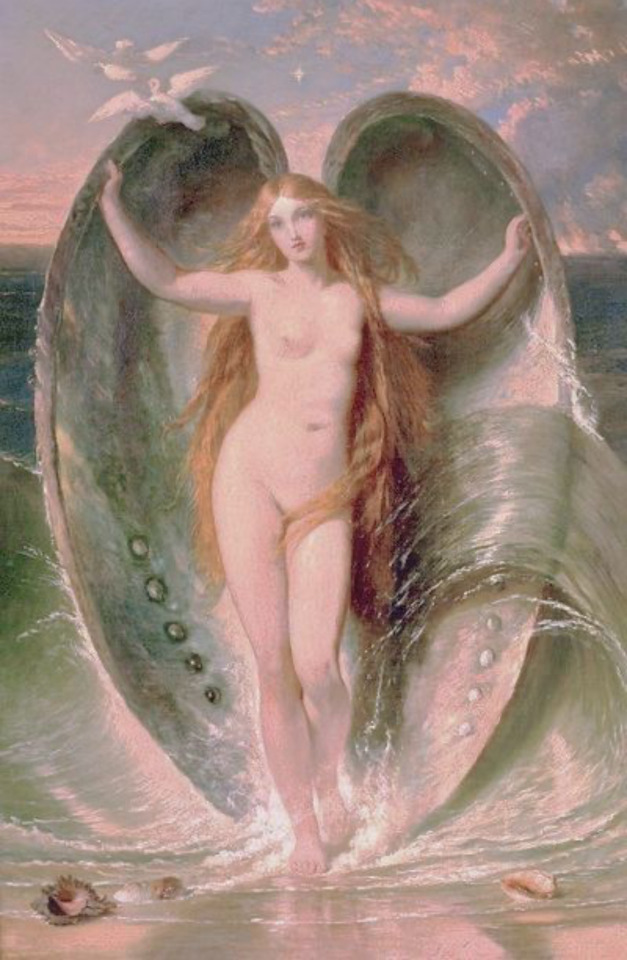
Aphrodite: Greek Goddess of love, beauty, sex and lust.
Aphrodite, the goddess of love and beauty, emerged from the sea in a scallop shell and sailed to Cyprus. She possessed a magical girdle and had many lovers, including Ares and Adonis. Ares killed Adonis out of jealousy, leading to the creation of anemones. Adonis became a god split between the Underworld and Earth due to Aphrodite's love. She travels with the Three Graces and bestows joy, brilliance, and abundance upon mortals. She aids in romantic love and is associated with myrtles, roses, and anemones.
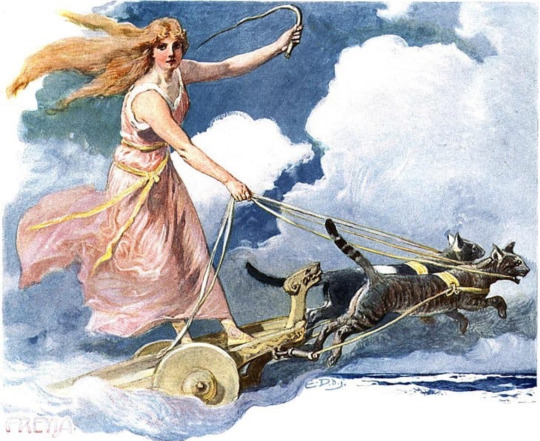
Freya: Norse Goddess of love, war, fertility and magic.
Freya, the Norse goddess of love and ruler of war and death. She mediated conflict between warring groups of Norse gods and established peace in Asgard. She is known for her beauty, sorcery, and sexuality, as well as for riding a cat-drawn golden chariot. Freya wears a falcon-feathered cloak that allows her to move quickly between heaven and Earth and has an enormous palace in Asgard where she celebrates with the souls she chooses from the battlefield. In one myth, she obtains the famous amber necklace, Brisingamen, from four dwarves by sleeping with them, beauty for beauty.
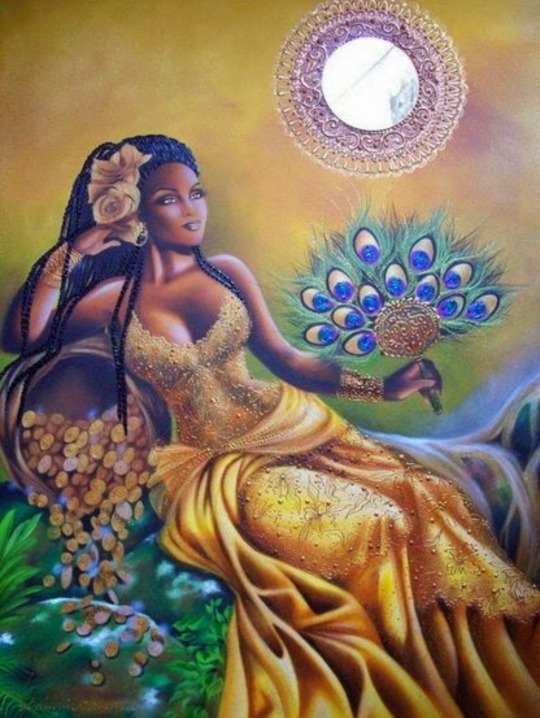
Oshun: African Goddess of love, beauty, prosperity & femininity.
Oshun is a goddess of love in the Yoruba religion. She is one of the 7 orishas and the source of power for all the other orishas. Oshun has the ability to make all things flow in the universe through her love and strength. She played a significant role in encouraging Ogun, father of civilization, to continue creating. Oshun is the only goddess who can carry messages between the mortal world and the Supreme Creator in heaven. In Nigeria, there is an annual ceremony called Ibo-Osun where women dance for Oshun during a feast of yams, with the best dancer winning Oshun's favor and becoming the village adviser on healing and fertility.
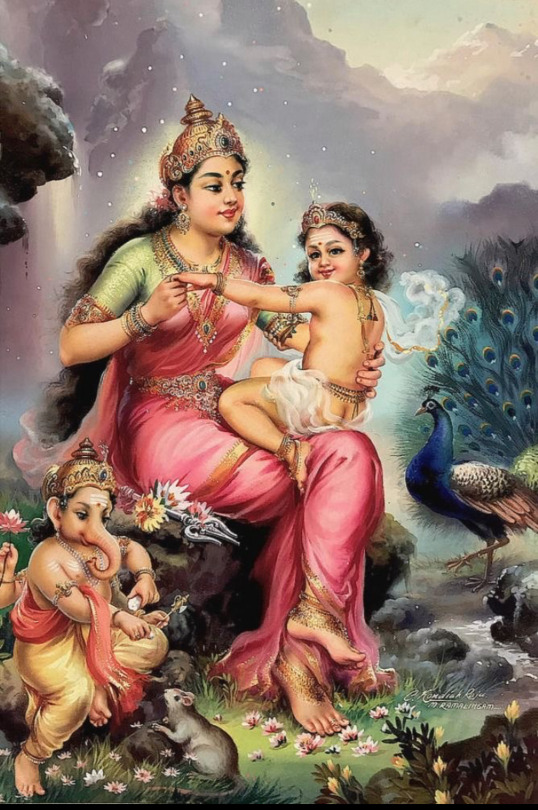
Parvati: Hindu Goddess of love, fertility, harmony and motherhood.
Parvati is a golden Hindu goddess known for love and devotion, forming a holy trinity with Saraswati and Lakshmi. She was born in the Himalayan mountains and embodies nurturing feminine energy. Parvati won over her husband, Shiva, through patience and determination in asceticism. Parvati is the creator of her son Ganesha, the elephant-headed god of wisdom. She is also worshiped for her strength and ferocity. In one legend, she transformed into the fearsome goddess Kali-ma to overcome & destroy demons who threaten the earth, showing her protective nature.
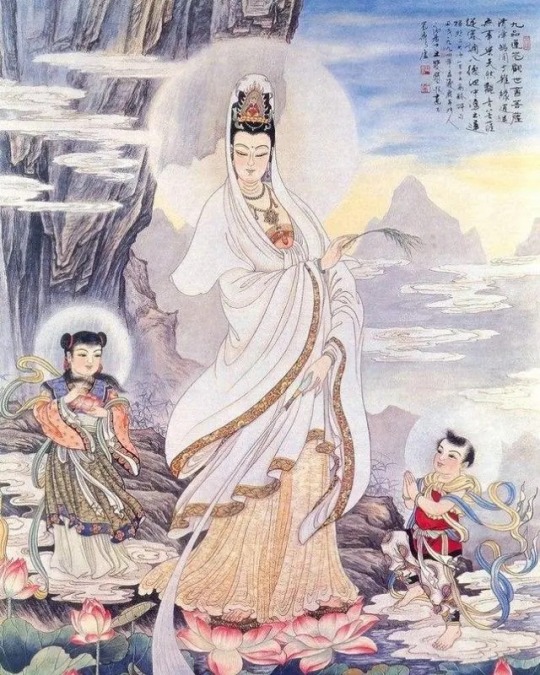
Guan yin: Buddhist Goddess of compassion, love, peace and kindness.
Guan Yin, originally a mortal princess named Miao Shan, was known for her compassion and kindness. Despite her father's cruelty, she devoted herself to helping others and performing miracles. After her death, she chose to remain in human form as a bodhisattva to help suffering beings, eventually becoming a goddess. By simply invoking her name, people can receive protection from harm. Guan Yin is often depicted in a white gown on a lotus throne and is revered by her followers as a symbol of love, compassion & purity. Her devotees often follow her vegetarian diet on her sacred days. Guan yin is not only the goddess of compassion, but the literal personification of it.
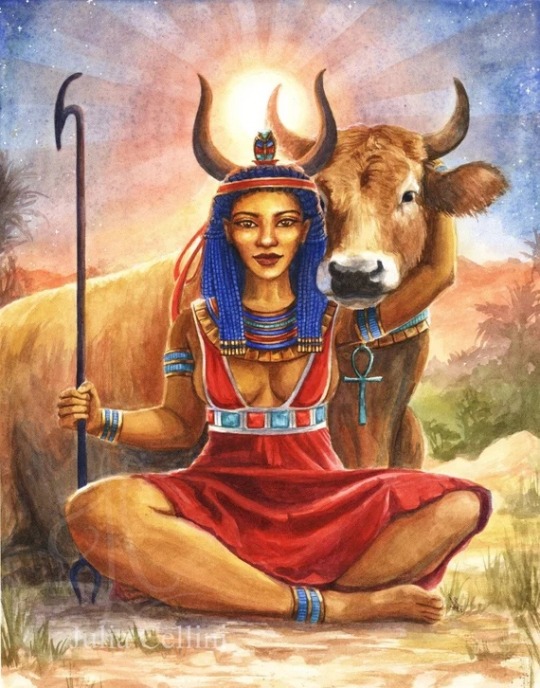
Hathor: Egyptian Goddess of fertility, love, womanhood and the sky.
Hathor, ancient Egyptian goddess of love and joy, has been revered for over 3,000 years. Known as the Gentle Cow of Heaven, she provided milk to the Sun God Ra, making him and other pharaohs divine. Hathor created the Milky Way and is often depicted wearing a crown with cow horns. She is worshipped through joyful ceremonies of music and dance and is the most beloved goddess in ancient Egyptian belief. Hathor is also the goddess of the Underworld, protector of females, and champion of romantic bonds. She can appear in different forms and her symbols are the sistrum and hand mirror.
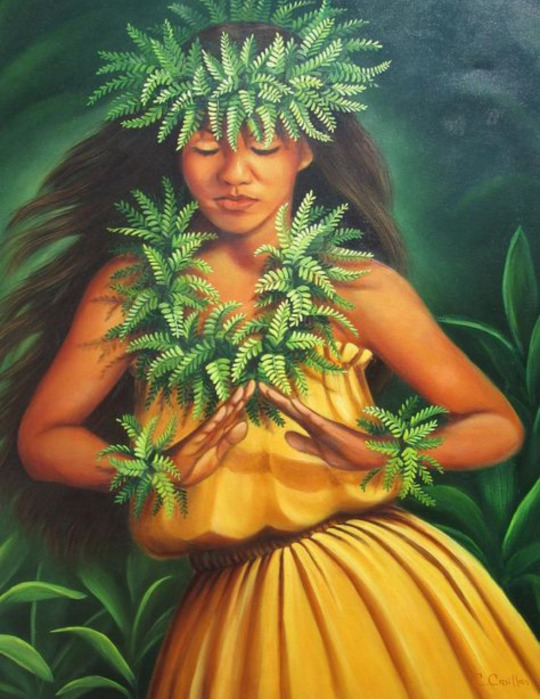
Laka: Hawaiian Goddess of love, wilderness, the hula & music.
Laka is a Polynesian goddess of love and wilderness who taught humans the art of the hula dance. She is married to the fertility god Lono, and rain is considered a sacred time for them. Dancers in training build altars to Laka with her favorite flowers and plants, and offerings are taken down to the ocean after performances to thank her for her blessing. She is a Goddess who rules over all vegetation. Plants sacred to her are: maile, Lama, hala pepe, `ie`ie, ki, `ôhia lehua, `ôhelo, and palai.

Aine: Irish Goddess of the summer, love, wealth and light.
Áine is a powerful and loving fairy queen in Irish legend, associated with agriculture, animals, and light. She is celebrated at the Midsummer Festival in Limerick, where people run up her hill to seek her blessing. She is also a survivor of sexual abuse in legends, where she shows strength and guides women to empowerment. Áine is depicted with red hair, a headband of stars, and surrounded by her animals. She can transform into a red mare who is unbeatable in speed.

Xochiquetzal: Aztec Goddess of fertility, beauty, flowers and love.
Xochiquetzal was a powerful and complex Aztec goddess known for her beauty and seductive nature. She was worshipped as a patroness of lovers and prostitutes, encouraging love-making for pleasure rather than reproduction. Despite her associations with sexual relationships, she also had the ability to absolve humans of sins unrelated to sex. She was married to the water god, Tlaloc, and was considered a consort to the creator deity, Tezcatlipoca. Xochiquetzal was widely worshipped and honored through great rituals that included acts of sacrifice and confessions.

Ishtar: Mesopotamian Goddess of love, war, fertility and power.
One of the oldest goddesses in the world, Ishtar, the goddess of war and sexual love, was the queen of heaven. Ishtar is considered a member of the special class of Mesopotamian gods called the Anunnaki. Ishtar is often called Inanna, she is also an astral deity, linked to the planet Venus, and was worshipped widely in the ancient Middle East. She was known as the Queen of the Universe and had powers attributed to various other gods. Ishtar was the very first goddess of love, Mesopotamians described her in her many legends and poems as young and strikingly beautiful, with piercing, penetrating eyes.
#Religion#hindu mythology#hinduism#chinese mythology#irish mythology#greek deities#greek goddesses#greek mythology#norse paganism#norse mythology#greek paganism#buddhism#paganism#deities#goddesses#Parvati#ishtar#mesopotamian#aztec mythology#Xochiquetzal#aine#Laka#hawaiian mythology#Polynesian#egyptian mythology#hathor#Oshun#Yoruba#african mythology#lotus-list
228 notes
·
View notes
Text

August 15, 2023: Yoruba priestess Aina-Nia leads a water ceremony by Lake Michigan as part of the Parliament of the World's Religions in Chicago. During the ceremony, which recognized the sacredness of water, water from different parts of the world was combined and poured into the lake.
Photo by Lauren Pond
#religion#yoruba#priestess#people#holy water#parliament of the world's religions#united states#divinum-pacis#interfaith
165 notes
·
View notes
Text
Papa Legba: The Gatekeeper of Haitian Vodou

https://ahavacelestialorder.org/papa-legba-the-gatekeeper-of-haitian-vodou/
The Dual Nature of Legba: Trickster and Teacher
While Papa Legba is primarily known for his wisdom and role as a guide, he also has aspects of the trickster archetype, particularly in his African origins. Similar to Eshu in Yoruba belief, Legba can be mischievous and unpredictable, reminding humans of the complexity of life and the delicate balance between chaos and order. He is sometimes depicted as testing individuals, forcing them to confront challenges or difficulties in order to gain wisdom or access to spiritual insights.
Legba’s role as a trickster is not malevolent but serves to teach important lessons about humility, respect, and the proper way to approach the spiritual realm. He may present obstacles to test one’s sincerity or to ensure that a person is prepared for the spiritual journey they are about to undertake. This dual nature of Legba as both a gatekeeper and trickster is vital to understanding his complexity and the deep respect practitioners hold for him.
7 notes
·
View notes
Text

Xangô, the king of orishas, lord of justice, thunder, lightning, fire and rocks
#shango#xangô#religion#spirituality#paganism#afro brazilian#yoruba#black men#candomblé#umbanda#mythology and folklore#ai art#ai generated
7 notes
·
View notes
Text

An excerpt of my annotations from Awo Falokun Fatunmbi’s text Ori.
Ori is the Yoruba word for one’s physical head, destiny, and consciousness. Here Baba Falokun is discussing the divination tray as a representation of the Ori to highlight its importance in the Yoruba cosmological scheme as well as divination’s purpose to help us explore its depths.
#black dark academia#noir library#dark academia#poc dark academia#divination#ifa#yoruba#orishas#ori#annotations#religion and spirituality#African religion
7 notes
·
View notes
Text
04.17.25 - Weekly Tarot/Oracle Reading
legend:
red: fire blue: water green: earth purple: air pink: the Divine; the Aether, Spirit, wtvr the fuck u wanna call it.
🔥 question 1: as the second week of my training comes to an end, what is it i need to know about mine and the collective's current progress in the energetic realm? 🔥
Ace of Wands: embrace new beginnings and creative ventures. A spark of inspiration leads to great achievements. 🔥
new beginnings
inspiration
creative potential
the spark of an idea, the start of a new project, a newfound sense of excitement and enthusiasm.
the element of fire, 🔥the spark of life, the energy that animates matter. when it appears, it represents a new idea, creative fervor, burst of motivation, kindling of confidence or fresh beginning involving something u feel passionate about.
this card urges u into action not merely for action's sake, but for the fulfillment of ur heart-driven purpose. all Aces are gifts from the Universe, but what we do with them is up to us. this one offers the gifts of fire, but it's only potential, not a sure thing. as the hand reaches toward the lighter, as in Mx. Charlie Claire Burgess's Fifth Spirit tarot deck, u have to reach out and take what's offered. u have to feed and fan the flame, nurturing ur ideas and passions from potential into reality. if u don't the spark will fizzle out.
overall, the energetic realm 🔥 is on the right track and has been for quite some time. maybe ur like me and u've just started kindling the flames of a new job, project or relationship that's doing wonders for u. maybe ur getting inspiration or preparing to start one of the above. either way, Universe is telling u to get a damn move on and start doin the shit that needs gettin done to fulfill that flame deep within your chest.
B.O.D.: THE SUN ☀️ - light, warmth, and vitality to everything it touches. an experience of being wholly ur authentic self, with ease and joy and no apologies. the Moon's shadows have been integrated, and now u get to enjoy a moment of rightness and bliss. visibility, as in being seen and appreciated by others. it might coincide with success, recognition or a celebration that has u all aglow. or it may be private, quiet, and simple: a day when your outfit has you feeling swaggy as fuck, or 20 minutes spent dancing to ur favorite tunes, or a leisurely afternoon in the dog park when, for a time, all feels right with the world. a spiritual knowledge that we're alive and part of an interconnected cosmic ecosphere; the ecstasy of the cell-deep knowledge that we are each as right, worthy and perfect as the trees, the animals, the sky and the Sun. 🌞
question 2.: how about the emotional realm? 🌊
the world, eight of wands, page of pentacles, two of cups.
u have come so fucking far, u have no goddamn clue.
The World: celebrate your achievements and reflect on your journey. now is the time to prepare for a new chapter in your life.
banishment, is the first thing i heard. a complete rejection of any negative energies, dark forces or thoughtforms, and toxic mindsets that have kept us anchored down to what no longer serves us.
💦 completion achievement fulfillment unity wholeness success 💧
eight of wands: prepare for rapid movement or decisions. now is the time to act quickly and trust where the current takes you. ☄️
fireworks about to explode 🎆 a fuse just begging to be lit 🧨 rapid movement, like a riptide in the current 🌊 or a healthy blue delphinium rising towards the sky 🪻. the path to success, passion and creativity; now's the time to light the fuse.
🧨 action movement change speed progress growth adventure excitement spontaneity momentum ☄️
page of pentacles: be open to exploring new opportunities for growth and learning. a message regarding finances or education may be coming.
a young child, maybe a young adult holding a baby sapling ready to be buried in the Earth and grow into a great beautiful redwood. a rainbow, shining brightly in the sky behind them, the pentacle disk laying at their feet.
i continued my studies of Afro-Brazilian divination and numerology methods today while training to begin my new job, as well as grading papers for my class. it made me feel whole, as though i have a purpose beyond working a day job and counting the days til i save enough to fulfill my vision.
🌲 youthful energy new beginnings education practicality focus stability potential. 🌏
two of cups: embrace the connection and mutual respect in your relationships. partnership and harmony bring growth.
two full cups, balancing each other out, filling each other when Water spills out on those rough days where things are a little rocky 🌊 the moon 🌙 and sun ☀️in opposite corners of the card, embracing the duality of night and day, good and bad, order and chaos.
maybe ur like me and u just started a truly fulfilling, non-toxic, solid relationship with someone really special. maybe ur like me, who knows what true romantic love feels like after not having had it for so long for so many reasons. maybe ur like me and u say u love them, just not quite out loud - in other ways, like paying for lunch or paying attention when they play the game til 4a or coming to visit while one's at work. if ur not and i'm just making u want to kill urself, this is ur sign to put urself out there, even if romantic shit isn't ur thing. im a demi transmasc pansexual blonde and kind of an asshole, i didn't think romance was EVER going to be an option for me, let alone with an emotionally intelligent cis guy who has their shit together. even if u're not looking for a partner, sometimes just a friend can give u that same warmth in ur chest that u long for on those bad nights when it feels like there's no point in coming home when there's no one to come home to.
🌊 love partnership balance harmony mutual understanding cooperation attraction commitment ⛲️
overall, if any of the above resonates it sounds like u're either in a good space or getting there right now. good, keep it that way - take care of ur body, mind and soul and the Universe will do the rest.
question 3.: well what about the mental realm?
queen of wands, page of swords, the emperor, the hierophant: the need to balance innovative thinking with established wisdom, and to lead with confidence while maintaining structure.
queen of wands: nurture ur passion and creativity. ur warmth and enthusiasm light the way for others. believe in ur power to inspire. 🔥
a bold, unapologetic, fiery energy. someone a bit mature, either physically or mentally, who understands how the world works and refuses to hide who they are for fear of persecution or hate regardless. someone who understands what it means to own themselves, and that that in itself is the cure to oppression and discrimination. someone who understands that sometimes, the people need someone to lead and that someone needs to step up and get shit done. that person is u. this card is telling u that yes, u are what they need to succeed; even if it seems like giving in to what they want in some way, understand that this is ur path to claiming ur personal power, to showing everyone exactly who u are and that the experience will yield unbelievably beneficial results. kick ass, take names, be gay, do crime.
🔥 confidence leadership determination passion personal power success. ☄️
page of swords: stay curious and question everything. your thirst for knowledge drives your exploration of the truth.
a young person on their way down the path of curiosities, the wind sweeping through their hair, their notebook or textbook in one hand and their sword in the other; [there's a reason percy jackson's sword is a pen.] someone eager to learn, quick-witted and perceptive -- someone with the ability to think on their feet. the need for new ideas, communication, and learning.
as i mentioned earlier, i continued my studies today in my culture's divination practices. i came to the united states when i was 2, and came back and forth between my father's family in brasil and his new family with my adopted stepmother until i was 7; i injured my knee during aerial silks and had to stay in the us for the surgeries since my adopted mother could afford it -- that's when i permanently moved to florida, in a little town called boynton beach. i've long since escaped that hellhole, but all of that is to say that i grew up essentially knowing one piece of where i came from before it all sort of...faded away. as i've grown older and found my way into spirituality and specifically, Chaos magick, i have felt a deep yearning to get in touch with all of my heritage, which lead me to discover another side of my Brazilian bloodline. my biological mother revealed that her family is originally a part of a Calão Romany community, that she escaped her arranged marriage which lead to her coming to my hometown. ever since, i've done deep research into what it means to be a Romany spiritualist because in reality -- there are not many, much to the disappointment of Hollywood, i'm sure. Romany culture is a closed practice and I've been doing my absolute best to remain respectful while learning about my culture, and I'm so happy to have learned so much in so little time. I am not a babalosha or priest yet, but i've learned my obatian (obaachan, Japanese for grandmother) has experience in Kimbanda and Umbanda practices from my father and auntie, so I'll be able to ask her about the initiation rituals and process of becoming officiated in Kimbanda divination and rituals. for right now though, i'm basically giving myself a little 101 intro course to prep for that.
all of that is to say, if you're like me and any of that resonated, this is your sign to either start or continue learning about whatever it is that feeds that hunger for knowledge, to fuel you on your pursuit of what cannot be known. know your limits -- some things cannot be known for a reason, and you shouldn't push that which you don't understand. if this applies to you in a spiritual sense as far as dealing with negative or malevolent entities and energies, please do the appropriate research and protection spells needed to face whatever it is you intend to face. Diego de Oxossi says "the practice of spirituality is based on the union of these three aspects:
consciousness: i know what i am doing and i do it of my free will.
magic: i seek divine intervention to transform the energies of the ritual elements into supernatural results.
purpose: i have a specific goal for what i'm doing and a specific plan as to what i'm going to do when i achieve it. "
he goes on to summarize that these aspects do not absolve u of the responsibility of ur actions, motivations and intentions -- do not do good things for the intent of bad motivation, for what goes around comes around and Spirit does not speak chess. there is no hiding things from the Universe; It made u. instead, ask It for guidance as to where ur putting your energy, because again, if ur like me and ur a bit too smart for your own good, u know that sometimes being subtle, indirect or cunning is not the right approach to take. sometimes it's okay to use that smartass mouth for something other than niceties and white lies to people please people into working with u. Lord Hermes is screaming at me and Inari Okami is sort of looking at me weird but it's fine. be brutally honest, tell people what's on your mind with little to no filter -- u might be shocked as to who agrees with u.
🌬️ curiosity learning communication news new ideas quick-wittedness perceptive adaptable energetic. 🗡️
the emperor: exercise authority and discipline. structure and stability are key.
well first off if ur transmasc ur totally passing, good shit dude. if ur not then ur just stepping into ur big dick energy, which in a world that favors the patriarchy is exactly what you need to keep going right now. emperor stands holding the parts to their next creation, their blueprints and tools scattered around them in somewhat organized order. ram's horns protrude from their forehead in an ethereal, Intangible Substance not quite visible to the naked eye (unless you look at it with another one). emperor represents stability, structure and authority, which, if ur like me is everything u fear hate despise want to kill with fire (can u tell im ADHD yet?). but sometimes its necessary, and as my partner loves to say, sometimes it's easiest to do it if u work within ur constraints.
hate waking up early as fuck for work? ask a friend to fall asleep on the phone with u so u can wake up and get ready together. accountabilibuddies, guys -- body doubling works. hate doing chores? create a thoughtform to manifest as the anthropomorphization of ur home -- give it a name, a backstory and an altar if u fucks wid it like that. mine is a kitchen spirit named Axina Kaliari, she's a lovely brown-haired dark-skinned Brazilian pombagira who sings songs with me while i do the dishes and the laundry, even when it hurts my back and sides to no end. don't wanna get in the shower cuz its Wet and u don't quite wanna be Wet yet? get some epsom salt in that shit, invite a deity u feel comfortable being nakey with (they know what humans are, they don't perceive clothes like we do its fucking fine and not inherently sexual unless They want it to be), say a prayer and wash off the miasma (spiritual grime and grit) -- boyle wasn't lying when he said washing ur hair is the ultimate romantic show of affection and self-love can count as romantic; i dated myself for the longest time and look where i'm at now. romanticize the shit out of ur routine and pretend ur in the montage of a cheesy 2000s coming-of-age movie and i swear ur life will end up feeling like one. the power of the mind is belief. u don't have to become a type A strict clean freak overnight, but a little bit of a routine will work out in ur favor if u customize it like an avatar's environment in Sims. the world is a computer simulation, u can put in whatever cheats hacks and bugs u want once u figure out how to work the system.
😌 stability structure authority power assertiveness order control 🥷
the hierophant: honor tradition and shared values. guidance may come from a mentor.
this one may seem to only be for me personally -- GO TALK TO UR FUCKING OBAACHAN U PROCRASTINATING SONUVABITCH !!
but maybe this resonates with u too -- the need to learn from someone in-person, consistently, who's experienced and understands what they're dealing with and how to teach it; someone who understands how u learn and how to present the material to u in a way u actually grasp the concepts efficiently; someone who can hand u a set of keys to answers of the mysteries of the unknown after learning everything it is u can to prepare urself for that experience. ego death is not fun, not if u do it right, yet it is necessary to access the parts of ur subconscious that will allow u to connect with that which is DIVINE. tradition can be rigid, unforgiving, and uncomfortable sometimes, sure -- but there are secrets to the Universe hidden inside them, like a scavenger hunt only meant for those on a specific path, and guess who's the goddamn scavenger? that's right, look in the mirror pal.
find a workshop class on tarot or channeling near u. get on socials and find groups and servers and communities that share ur interests. do some shadow work and meet with ur higher self to get some guidance on the future; hell, ask one of or more of ur deities to start teaching u something specific, like woodworking or needlepoint or wtvr the fuck else u nerds do in ur spare time - i asked Lord Ares to guide me while playing marvel rivals as magik for the first few times and guess who got MVP twice inna row?? this guy right here *finger guns*
🪬 tradition religion spirituality guidance wisdom meaning connection to a higher power 🔮
this is where i'm going to leave it for tonight, but it seems that everyone is feeling some version of blessings in their life right now, and i pray to my Divine Court that u get to enjoy it as much as i've been so far. go follow my tiktok im funny as fuck. i'm gonna set up shop for consultations by tarot and energy work soon, lemme know if anyone's interested. bye for now sheeple.
#tarot cards#tarot reading#nightly tarot reading#fifth spirit tarot deck#cultural heritage#emotional growth#spirituality#divination#education learning all that good shit#jeez sometimes i forget these are for me as well i gotta start taking my own advice#lord hermes#hermes worship#hermes greek god#hermes greek mythology#hellenic paganism#inari okami#inari#kitsune#kitsune vessel#shintoism#orixas#orishas#yoruba#candomblé#batuque#umbanda#kimbanda#afro-brazilian religions#romany#romany witch
5 notes
·
View notes
Text
ILEKE BEADS IN THE IFA TRADITION
Ileke beads, sometimes referred to as Ifa or Orisha beads, are a type of beaded jewelry that can be found in Nigeria and other parts of Africa. The word ileke means “bead” in the Yoruba language. Seeds, beans, and stones are kneaded together to form these elaborate fetishes. The beadwork is created by stringing together ornate objects of various shapes and sizes to form patterns.
These totems are used by some people as a form of currency, while others use them for religious or spiritual purposes. Notably, ileke beads are an important part of the Ifa religion and other African traditional religions. They are used in many ceremonies and rituals similar to rosary beads in other religions like Islam, Catholicism, Buddhism, etc.

COLOR MEANINGS AND ORISHAS
Ileke beads come in a variety of colors and styles. However, the most common color is white, as it can be used for various deities or Orishas. However, they can also be found in a mixture of black, green, red, and other colors that symbolize different Orishas.
Here are some examples below:
White for Aje
Yellow for Oshun
White for Obatala
Red and black for Eshu
Green and black for Ogun
Green and yellow for Orunmilia
Note that the color of the beads associated with each Orisha can vary by house and tradition. For instance, Ogun is often represented by the color red in diasporic traditions like Lucumi and Santeria, etc. So, you may find discrepancies in the colors as outlined above.
THE PURPOSE OF THESE TOTEMS
The ultimate purpose of ileke beads is for spiritual protection. They ward off evil spirits and bring good luck. The Yoruba people believe that they have spiritual power. They are a symbol of wisdom and knowledge and are used in many ceremonies and rituals. These spiritual totems are also said to be blessed by the gods, which makes them even more special.
An Ifa devotee should always wear ileke beads on the wrist or around the neck. These blessed adornments can protect the wearer from the conspiracy of enemies and onlookers. They can also keep death at bay and sickness away.
Ileke beads should be consecrated by an Ifa priest or priestess in order to serve their primary function. They can be bought from spiritual suppliers and practitioners. However, they won’t possess the essence of an Orisha or spirit unless they are consecrated or blessed.
WHERE TO FIND ILEKE BEADS
If you want to wear ileke beads, it is best to consult with an Ifa priest or priestess to see if they are appropriate for you. They can be worn by anyone, but it is important to ensure that they are consecrated when using them for spiritual purposes. Also, you should be aware of any taboos associated with wearing these totems before purchasing them.
If you are interested in learning more about ileke beads and the Ifa religion, you can purchase them in our online store. You can also visit a local Ifa temple or shrine to see ileke beads in person.
6 notes
·
View notes
Text

Yemaya by Kypris Aquarelas
#paganism#polytheism#pagan#goddess#deity#art#religion#yemaya#iemanjá#yemoja#mami wata#mother goddess#umbanda#ocean#god#yoruba#dandalunda#mikaia#samba#brazil#brasil#watercolor#watercolour#candomblé#santeria#voodoo#nkisi#inquice#orixá#orisha
115 notes
·
View notes
Text
So the thing with Tems had me thinking a little bit.
More Black people who were raised Christian and left the religion are turning towards Ifá/Santeria/Candomblé or Òriṣà worship in general for many reasons.
Just know that not all Yoruba people are open to that. colonization did it's thing at demonizing that practice to many people. I'm part of the lucky few Yoruba people who's family still respects our heritage and honour the Òriṣà even though most practice Islam or Christianity. My dad side is still a Ṣàngó house, my mum side Ọṣun house.
If you meet a random Yoruba person and start talking about Òriṣà they might call it idol worshipping and rebuke it in the blood of Jesus Christ because they might be Catholic or something. Or they might say there is no God other than Allah because they are Muslim.
As a Yoruba person not even I would assume some respected the traditional religions. I have had arguments with fellow Yorubas and Igbos and other ethnic groups in Nigeria and West Africa while waving around the novel Things Fall Apart
It's just something to keep in mind.
47 notes
·
View notes
Text

"Le miel d'Oshun", acrylic on paper, 21 x 29,7 cm
Instagram : @jenekacy_art
#oshungoddess#oshun#oshunenergy#acrylicpainting#illustration#acrylicillustration#witches of color#santeria#africanart#ifa#west africa#yoruba#candomble#my art#contemporary art#hoodoo#honey#love goddess#afrofantasy#afro witch#africanspirituality#african traditional religions#african spirituality#oxum
102 notes
·
View notes
Text

Odò Ìyá!
45 notes
·
View notes